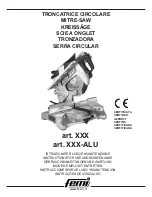
English
– 11
SAFETY INSTRUCTIONS
Cutting blades
General
Cutting blades are available in two basic designs; abrasive
discs and diamond blades.
Always remove the cutting blade when the machine is
transported.
Make sure that the right bushing is used for the cutting blade
to be fitted on the machine. See the instructions under the
heading Assembling the cutting blade.
High-quality blades are often most economical. Lower quality
blades often have inferior cutting capacity and a shorter
service life, which results in a higher cost in relation to the
quantity of material that is cut.
Water cooling
After using an abrasive disc with water cooling, run the disc
dry for about half a minute. If an abrasive disc is stored in
humid conditions, this can cause imbalance and result in
injury.
Hand-held, high-speed machines
Our cutting blades are manufactured for high-speed, portable
power cutters. If blades from other manufacturers are used,
ensure that the blades conform to all regulations and
demands that concern this type of power cutter.
Special blades
Some cutting blades are designed for stationary equipment
and for use with attachments.Such cutting blades must not be
used on portable power cutters.
Always contact local authorities and make sure you are
following applicable directives.
Abrasive discs
The cutting material on abrasive discs consists of grit bonded
using an organic binder. ”Reinforced blades” are made up of
a fabric or fibre base that prevents total breakage at maximum
working speed if the blade should be cracked or damaged.
A cutting blade’s performance is determined by the type and
size of abrasive corn, and the type and hardness of the
bonding agent.
Check that the blade is approved for the same or higher
speed according to the aproval plate of the engine. Never use
a cutting blade with a lower speed rating than that of the
power cutter.
Ensure the blade it not cracked or damaged in any other way.
Test the abrasive disc by hanging it on your finger and tapping
it lightly with a screwdriver or the like. If the disc does not
produce a resonant, ringing sound it is damaged.
!
WARNING! A cutting blade may burst and
cause injury to the operator.
Never use a cutting blade at a lower speed
rating than that of the power cutter.
Never use a cutting blade for any other
purpose than that it was intended for.
!
WARNING! Cutting plastics with a diamond
blade or rescue blade can cause kickback
when the material melts due to the heat
produced when cutting and sticks to the
blade.
!
WARNING! Water cooling, which is used
when cutting concrete, cools the blade and
increases its service life while also reducing
the formation of dust. Disadvantages include
difficulties at very low temperatures, the risk
of damaging floors and other structural
elements, and the risk of slipping.
Abrasive discs, types and use
Use
Disc type
Material
Water cooling
Concrete
Concrete, asphalt,
stone masonry, cast
iron, aluminium,
copper, brass,
cables, rubber,
plastic, etc.
Can be used to
reduce dust. Run the
disc dry for about a
half minute after
using an abrasive
disc with water
cooling.
Metal
Steel, steel alloys
and other hard
metals.
NOT recommended
Summary of Contents for 396K
Page 23: ......









































